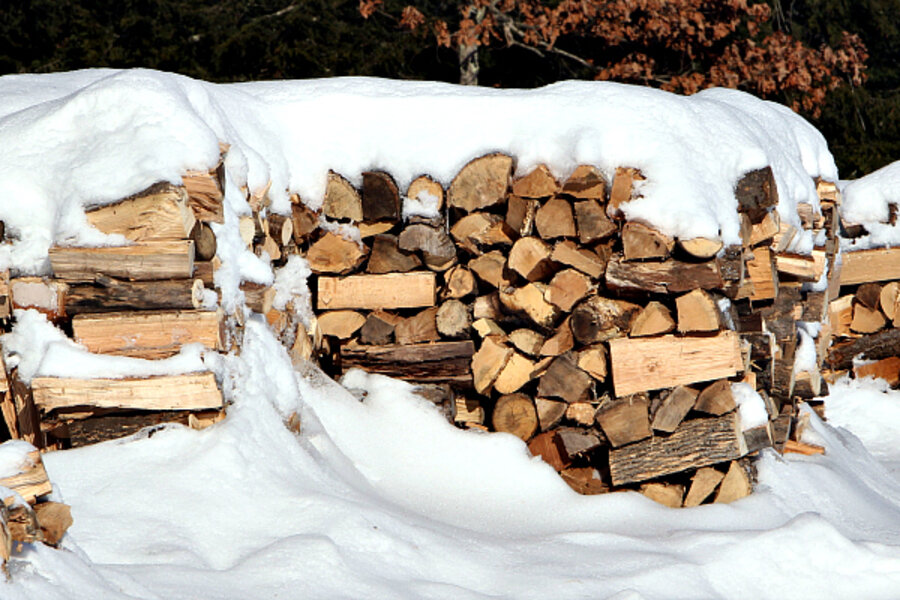Firewood donations stock the stoves of the needy
Loading...
| Concord, N.H.
In a wintertime take on food pantries, some northern New England communities are helping needy families stock their woodstoves instead of their shelves.
Just 2 percent of homes nationwide are heated with wood, but that percentage is four times higher in New Hampshire, more than six times higher in Maine, and nearly nine times higher in Vermont, according to 2012 census estimates.
While benefits obtained through the federal Low Income Home Energy Assistance Program can be used to purchase wood, community wood banks run by church groups, social service agencies, and towns help those who don't qualify or find themselves in a midwinter emergency and don't have time for the application process.
"It's wonderful that we have the fuel assistance program, but that's a service you need to apply for ahead of time, and oftentimes, there are situations out of a person's control," says Kristen Vance, executive director of Grapevine Family and Community Resource Center in Antrim, N.H.
Ms. Vance and her husband started the center's Community Wood Bank 10 years ago after a local church that had been running a small wood bank was about to shut it down. Last year, it served three-dozen individuals and families. One recent recipient was a man who had rented out his home while he visited out-of-state relatives and returned to find his house had been vandalized and the heating system damaged.
"His house was about the same temperature it was outside, and he didn't have any fuel, so he came over and got some wood," Vance says.
Some of the firewood banks make home deliveries, while others are self-serve operations. All rely on the generosity of volunteers to cut, split, and pile up wood.
In New Hampton, N.H., Tom O'Shea started picking up dead trees on the side of the road eight years ago and storing them at his home. Soon, half-a-dozen fellow members of the New Hampton Community Church were doing the same, and they eventually approached their pastor about setting up a system to distribute the wood.
Today, the group arranges deliveries in the late fall to six or eight homes and keeps a stockpile for later in the winter if folks run out. Instead of clearing deadwood from roadsides and other lots, the group now buys log-length wood and chops it up into stove-size pieces, providing about 10 cords of free firewood per winter.
"There's no greater gift than being able to bring wood to somebody — most are women with kids, and they're frozen. It does my heart good to be able to walk in there with a third or half a cord of wood and give it to them," O'Shea said.
In Maine, the Cumberland Wood Bank delivered 35 cords of wood to people in need last year and raised almost $9,000 to pay for propane and oil to help residents stay warm, says Susan Novak, business manager at the Cumberland Congregational Church. A few years ago, the church started getting phone calls from people who didn't have enough wood to burn throughout the winter. Meanwhile, community members clearing their land didn't know what to do with their extra wood, and the idea was born, Ms. Novak says.
In Vermont, the state donates wood to several volunteer groups that work with the United Way of Lamoille County. Unlike other less formal arrangements, those seeking the wood have to apply in August or September, and the United Way determines income eligibility and handles other logistics.
State officials also were involved in giving an unexpected boost to a nonprofit program in Bennington, Vt., called Wood Warms that serves people who don't qualify for federal fuel assistance but are still struggling.
In the fall, U. Forest Service law enforcement officials seized more than 20 cords of firewood that was stolen from the Green Mountain National Forest and donated it to the program. Individuals on probation and parole, as well as high school students from the Southwest Vermont Career Development Center, helped cut and split it.
Mary Congoran and her husband started Wood for Warmth in Hopkinton, N.H., in 2008. Since then, town officials have embraced the idea, allowing the wood bank to set up at the town transfer station.
The wood is donated from several timber-related businesses, and the program includes a "volunteer day" each fall to split and stack it. Ms. Congoran scouts around in October for families who might need help, and residents apply for vouchers from the town's human services department that can be redeemed at the wood bank.
"One of the difficulties is, this is New Hampshire, and a lot of people just won't ask for help. They say, 'There's gotta be someone else who needs it more than I do,' " she says.
While her program is more formal, Congoran says helping others doesn't have to be complicated.
"Just have a wood pile, and it can grow from there," she says.
• Associated Press writers Alanna Durkin in Augusta, Maine, and Wilson Ring in Montpelier, Vt., contributed to this report.







